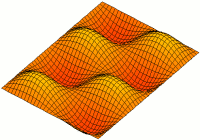Resonator
Resonator refers to a device or system that naturally oscillates at some frequencies, called its resonance frequencies, with greater amplitude than at others. The principles of resonance find applications across various fields, including physics, engineering, acoustics, and electronics. Resonators are used to either generate waves of specific frequencies or to select specific frequencies from a signal. They play a crucial role in many devices, from simple musical instruments to advanced lasers and quantum computers.
Types of Resonators[edit | edit source]
Resonators can be broadly classified into two categories: mechanical and electromagnetic.
Mechanical Resonators[edit | edit source]
Mechanical resonators work on the principle of mechanical vibrations. Examples include tuning forks, which resonate at a specific pitch when struck, and quartz crystals used in quartz watches and oscillators. These devices rely on the physical properties of materials to produce a precise frequency.
Electromagnetic Resonators[edit | edit source]
Electromagnetic resonators involve the resonance of electromagnetic waves. They include:
- Cavity resonators, which are used in microwave ovens and certain types of radars.
- Optical resonators, which are fundamental in the operation of lasers, trapping light between two or more mirrors to create standing waves.
- LC circuits (inductor-capacitor circuits), used in radio transmitters and receivers to select a specific frequency from a broad spectrum of signals.
Applications[edit | edit source]
Resonators have a wide range of applications:
- In musical instruments, where they amplify sound at certain frequencies to produce musical notes.
- In timekeeping devices, where the regular vibrations of quartz crystals help in keeping precise time.
- In telecommunications, resonators filter out unwanted frequencies and stabilize the frequency of signals.
- In sensors and actuators, to detect or produce vibrations at specific frequencies.
- In medical devices, such as MRI machines, where they help in creating images of the body's interior.
Design and Operation[edit | edit source]
The design of a resonator depends on its intended use. Mechanical resonators might be designed based on the size, shape, and material properties to achieve the desired frequency. Electromagnetic resonators are often designed considering the wavelength of the electromagnetic waves they are meant to resonate with. The quality of a resonator, indicating how selectively it can resonate at the desired frequency, is measured by its Q factor. A higher Q factor indicates a narrower range of frequencies around the resonance frequency.
Challenges and Innovations[edit | edit source]
One of the main challenges in designing resonators is managing losses, which can dampen the resonance. In mechanical resonators, this might be due to material imperfections or energy leakage. In electromagnetic resonators, losses can occur due to imperfect conductors or dielectric losses in insulators. Advances in materials science and engineering have led to the development of high-Q resonators for various applications, from ultra-stable oscillators for timekeeping to high-power lasers for cutting and welding.
Conclusion[edit | edit source]
Resonators are fundamental components in a wide array of devices and systems, harnessing the principle of resonance to filter, generate, or amplify frequencies. Their design and operation are critical in fields ranging from telecommunications to medical imaging, making them a cornerstone of modern technology.
| This article is a stub. You can help WikiMD by registering to expand it. |
Search WikiMD
Ad.Tired of being Overweight? Try W8MD's physician weight loss program.
Semaglutide (Ozempic / Wegovy and Tirzepatide (Mounjaro / Zepbound) available.
Advertise on WikiMD
|
WikiMD's Wellness Encyclopedia |
| Let Food Be Thy Medicine Medicine Thy Food - Hippocrates |
Translate this page: - East Asian
中文,
日本,
한국어,
South Asian
हिन्दी,
தமிழ்,
తెలుగు,
Urdu,
ಕನ್ನಡ,
Southeast Asian
Indonesian,
Vietnamese,
Thai,
မြန်မာဘာသာ,
বাংলা
European
español,
Deutsch,
français,
Greek,
português do Brasil,
polski,
română,
русский,
Nederlands,
norsk,
svenska,
suomi,
Italian
Middle Eastern & African
عربى,
Turkish,
Persian,
Hebrew,
Afrikaans,
isiZulu,
Kiswahili,
Other
Bulgarian,
Hungarian,
Czech,
Swedish,
മലയാളം,
मराठी,
ਪੰਜਾਬੀ,
ગુજરાતી,
Portuguese,
Ukrainian
Medical Disclaimer: WikiMD is not a substitute for professional medical advice. The information on WikiMD is provided as an information resource only, may be incorrect, outdated or misleading, and is not to be used or relied on for any diagnostic or treatment purposes. Please consult your health care provider before making any healthcare decisions or for guidance about a specific medical condition. WikiMD expressly disclaims responsibility, and shall have no liability, for any damages, loss, injury, or liability whatsoever suffered as a result of your reliance on the information contained in this site. By visiting this site you agree to the foregoing terms and conditions, which may from time to time be changed or supplemented by WikiMD. If you do not agree to the foregoing terms and conditions, you should not enter or use this site. See full disclaimer.
Credits:Most images are courtesy of Wikimedia commons, and templates, categories Wikipedia, licensed under CC BY SA or similar.
Contributors: Prab R. Tumpati, MD




